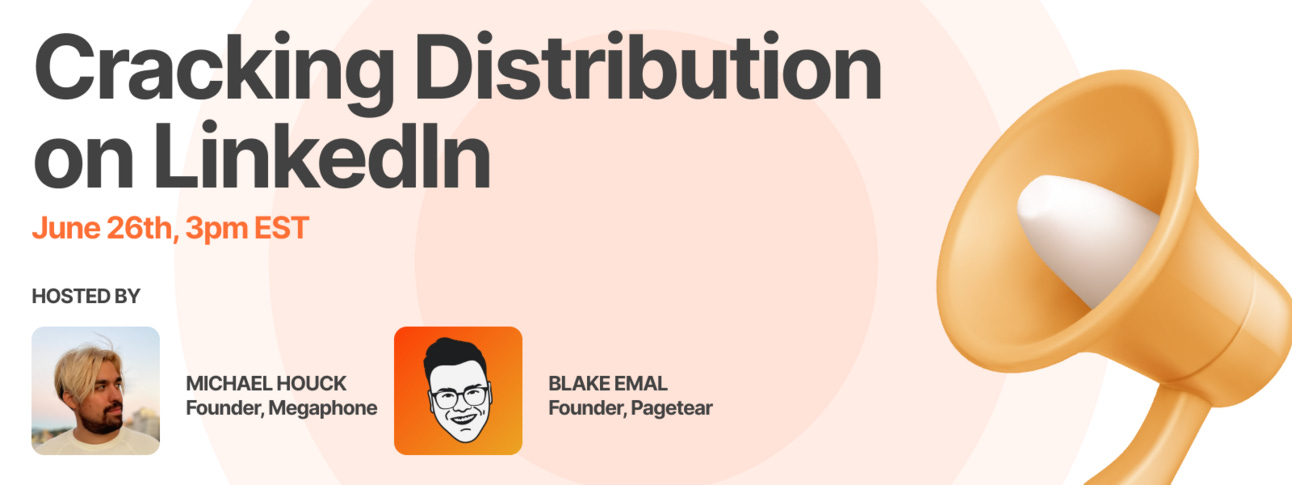Hey y’all — I’m hosting a live workshop on how to crack distribution using LinkedIn with my friend Blake Emal on June 26th at 3pm EST (RSVP here).
We’ve leveraged LinkedIn to build Megaphone Studio, our content + distribution agency that’s helped founders add over 4 million total followers and do over 605 million impressions.
Hope to see you there!
Anyway, this week I’m sharing a story from this week when I went deep with a founder friend on their product and made a counterintuitive proposal that reminded me:
Users want things, but they don’t see the future — founders do.
Remember, You’re Building the Future
Founders Have the Vision
This week I was helping a friend with their product strategy and we hit on something that served as a reminder for us both:
Users can’t see the future.
Yes, YC is right, you should (say it with me) make something people want, but founders are the ones that shape those raw wants (“better", “faster", “cheaper”, etc) into offers, products, and services.
The classic example is that users would have told Henry Ford to build a faster horse, but he saw the future.
He knew that something new was now possible which would be better because he realized that they didn’t actually care about the horse — they cared about getting where they were going.
Once the tech needed for reliable, safe, and quick (enough) cars was possible, who wants a horse that you have to feed and let rest and manage?
Visualize the Future
The friend I was helping is building an AI product that reaches out to people on your behalf.
It writes messages at scale so you don’t have to.
The problem? Sometimes AI writes messages that aren’t exactly right in subtle, hard-to-systematically-fix ways. Not obvious hallucinations, but context that only exists in your head, like your prior relationship with someone.
They’d built in a simple way to review and edit messages before they went out so users had total control, but the friction of having to do the reviews was stopping users from sending out enough messages.
And they had an autopilot mode, but users weren’t opting into it.
The users could see that not every message was perfect, which degraded their trust in the product.
So I told them to visualize what the future state looks like. Would a product that requires edits and approvals become a billion dollar company, if even their early users didn’t want to do that step?
The answer was obvious once we framed it that way.
Find the Vector that Matters
Like a faster horse, no one really cares about how messages get sent.
What they want is to book calls and grow their pipeline in greater volume and less time.
In my friend’s case, the path to a big company is through sending messages in high volume on autopilot. It’s something that AI enables that wasn’t possible before.
But, today, users don’t trust it enough because:
They can see that not all messages are going to be perfect
They have to clean up the mess if an imperfect message goes out
If you were strictly listening to user feedback about this, they’d lean away from autopilot and send in feature requests for improvements to the UX or edge case bugs with message quality (since they’re spending all their time there, editing and approving).
The last thing most of them would tell you is that they should adjust the product to only allow autopilot, with no reviews at all.
But that’s exactly what I recommended my friend should do.
I’ll say it again: users don’t know what the future looks like. It’s up to us to understand what they want, and use technology to provide a truly better way for them to do it.
There is no magic bullet UI or UX that will make people want to do something they don’t want to do (like approving and editing individual AI-generated outbound messages).
So instead of trying to skirt around it, build the experience for the future and find novel ways to augment user fears.
In this case, I recommended my friend build a “faux pas insurance” system where users can press a button after a message has been sent that would send a follow up saying something like “sorry, that was just my AI.” And use that data to help the system eventually learn to do that on its own.
Sounds a little crazy, and maybe it is, but as people get more comfortable with AI sending messages I think features like that will become more common too.
It’s an attempt to get trust high enough to where people actually prefer the new workflow (because the gains from the benefits outweigh their concerns).
My point is that you need to 1. find the vector that truly matters to your users and 2. build for it — addressing concerns along the way.
Focus on what’s new and uniquely better, not on building a faster horse.
It’ll be bumpy (the first cars were awful) but that’s ok — remember, you’re building the future.
How We Can Help
Become a member to get full access to our case study library, private founder community, and more.
We can also help your startup in a few other ways:
Content Creation
Let my team and I ghostwrite for your newsletter, X, or LinkedIn.
Growth
Grow your audience + generate leads with my growth service.
Fundraising
Share your round with hundreds of investors in my personal network.
Advising
I’ll help solve a specific challenge you’re facing with your startup.
Advertise in my newsletter to get in front of 75,000+ founders.






